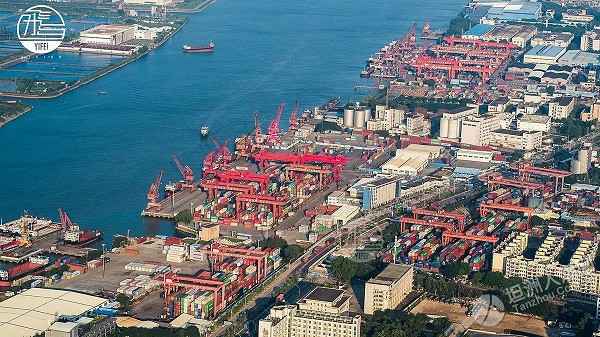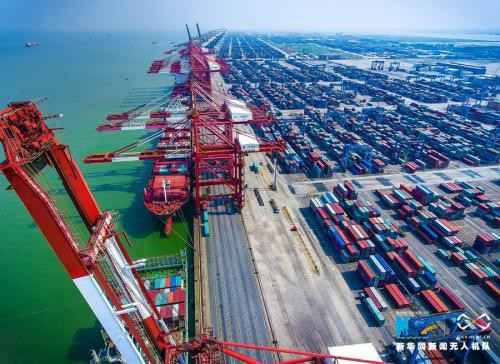


East Changer has service outlets at major ports to integrate resource advantages and provide fast, efficient and standardized customs clearance services for customers to import and export goods at different ports, thus ensuring efficiency of customs clearance.
① Hong Kong-Zhuhai-Macao Bridge
Hong Kong-Zhuhai-Macao Bridge is the first cross-border land transport corridor connecting Hong Kong, Zhuhai and Macao. It is a large-scale cross-sea traffic project of the century, which crosses Lingdingyang Estuary, connects Hong Kong to the east, and connects Zhuhai and Macau to the west. The bridge adopts the customs clearance mode of three places-three inspections. Between Zhuhai and Macao, an innovative model of “cooperative inspection, one release” is conducted. Since the establishment of the bridge, East Changer has represented many times to import goods through the bridge. The customs declaration in Zhuhai adopts the mode of declaration in advance to ensure the smooth and convenient customs clearance of goods.
Before the establishment of the bridge, it was generally 1-2 days for the port by using barges to transport the import and export goods. It cost at least 4 hours if bypassed to Humen Bridge, it was even 8 hours if there was traffic jam. At present, transported by the Bridge can shorten the logistics time of Hong Kong to Zhuhai and Macao to less than one hour, and integrate the western part of the Pearl River Delta into Hong Kong's three-hour drive, which greatly improve the efficiency of inbound and outbound transportation operations and reduce the transportation logistics costs of Hong Kong, Zhuhai and Macao effectively. Establishment of the Bridge has opened up new channels for logistics and customs clearance in Guangdong, Hong Kong and Macau. Zhongshan and Zhuhai will become important logistics nodes. The future development is expected.

② Zhongshan Port
ZhongShan Port International Container Terminals. Zhongshan Port is located in the south of Pearl River Delta Center, which is adjacent to Shenzhen and Hong Kong (55 nautical miles from Hong Kong, 38 nautical miles from Macao, 110 nautical miles from Yantian, Shenzhen and 45 nautical miles from Shekou). The waterway of Hengmen is 6 meters deep and the channel is 120 meters wide (designed according to 3,000-ton vessel channel). Water and land transportation is convenient, the location advantage is obvious, the hinterland is wide, and the goods can be exported on the same day to ensure the timeliness of transportation. Zhongshan Port is one of the fastest import and export channels for the Pearl River Delta.

③ Nansha Port
Nansha Port is located in Longxue Island on the west bank of Nansha District in Guangzhou, south to the South China Sea, east to Shenzhen, west to the South (sea), Fan (Yu), and Shun (De). Nansha Port is located in the geographical geometric center of the Pearl River Delta and is the only way to the sea of Guang-Fo Economy Zone and city in the west of Pearl River Delta; its 100-kilometer radius covers the entire Pearl River Delta urban agglomeration and is a pivotal node connecting the urban agglomerations on both sides of Pearl River Delta.
As of the end of March 2016, 65 international routes opened in Nansha Port increased the liner density; 53 “shuttle bus” container barge feeder lines have covered Pearl River Delta port group basically; 15 dry ports have already radiated the collection and cargo system to PPRD region. Nansha Port promoted the international AEO mutual recognition system actively and established Guangdong-Hong Kong cross-border warehouse (Super Main Line). The implementation of these measures has achieved mutual recognition of port information sharing and inspection results, and enhanced the adsorption and allocation capabilities of shipping resources in both domestic and international markets. In 2015, cargo throughput of in Nansha Port has reached 282 million tons, up 11.7% year-on-year; container throughput was 11.77 million TEUs, up 6.3% year-on-year, and individual ports ranked the top 12 in the world.
Nansha Port has an excellent customs clearance environment. In October 2008, the State Council approved the establishment of Guangzhou Nansha Bonded Port with a planned area of 7.06 km2, which includes Nansha Port Phase I, Nansha Port Phase II, Nansha Logistics Park Phase I, Jianghai Intermodal Terminal and Nansha Export Processing. Area. At present, the Port has completed the construction of hardware facilities and information systems in the bonded port successfully. On 9th July, 2009, Guangzhou Nansha Bonded Port (Phase I) passed the formal inspection and put into use by the state. 24-hour customs clearance service provides convenient customs declaration. Customs clearance mode of “Customs declaration in multi-point, inspected and released in Nansha” and convenient customs clearance of international goods are implemented.


FOLLOW
Copyright ©2018 Zhuhai-Macao Cross-border Industrial Zone East Changer Storage Co., Ltd.
粤ICP备10024348号-1
